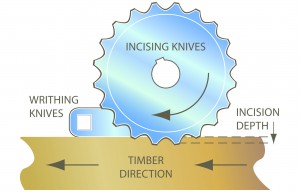The Timber Incising Process
Incising is a pre-treatment mechanical process in which bespoke designed blades are inserted into the face and edge of the timber section longitudinally. By passing the sawn timber products through the machine, a consistent pattern of incisions are applied to each face of the product that then provide highways for the preservative chemical to penetrate the product in the following treatment process. The machine feed speed, incision pattern, density and depth can all be varied depending on the target market and product.
Incising as a routine technique for improving preservative penetration and retention is primarily used in the United States (Crawford et al 1999) and Canada. The techniques are also being employed to some extent in Japan for railway sleepers and South Africa for wood poles.

The techniques are employed to a much lesser extent in Europe and Australia. Incising is applied to a variety of timber species, including Western hemlock (Bramhall 1967), Douglas fir (Perrin 1978), Japanese cedar (Hattori 1957) and spruce (Schulz 1971). Railway sleepers and other square sawn timbers are incised on all four sides completely along the length of the timber. The first commercial incising machine for square timbers was built in the USA in 1915 and the first practical pole incising machine in 1920.
Incising is a relatively simple and potential cost-effective additional step in the processing of sawn or round timber that can enable wider applications of the treated timber end product.
The Porcupine Incising machines are designed to incise all 4 faces of a piece of square sawn timber for example a Fence Post or Sleeper as it travels through the machine.
The incising is done by rotating heads that are variable sprung loaded to cope with the variation within a timber section including different timber density and knots.
The blades make a pattern of incisions into the timber as it travels through the machine, the incising heads are synchronised to give a pattern of incisions which are closely spaced to ensure sufficient levels of penetration.
Incorporated into each head is a writhing/cleaning knife system which provides three important functions to the machine:
They clear out any build up of debris between the blades.
They act as a guide for the timber and hold it in the correct position to ensure equal depth incisions to all four faces.
They prevent tear out of timber on the faces of the post caused by the incising knives.

Advantages of Incising Timber
The key advantages of incising timber are:
- Improved penetration and retention of wood preservative. In BRE field trials incising spruce prior to preservative treatment doubled the uptake of preservative and appeared to double the service life of the treated stake.
- Porcupine incised products have a sympathetic, aesthetic look closely mimicing unincised timber. This is in comparison to the more aggressive North American incision patterns which have a less desirable visual appeal.
- The treatment produces a uniform penetration envelope that is quantifiable.
- Ability to demonstrate conformity with European Specification Standards.
- Improved durability of treated commodity.
- Reduced stresses in commodity (reduced checking of surface.)
- Reduced drying time (species dependent)
- Reduced risk of premature failure of treated timber and the potential benefit of reduced timber waste volumes.
- Consistent supply of material into potential end uses in the UK (e.g. highway fencing.)
The North American incising pattern has wider, less aesthetically pleasing blade incisions. Porcupine incised pattern is aesthetically pleasing and high technical performance.
Criticism levelled at incising has been based on the reduction of bending properties. Research has shown that the modulus of rupture is reduced by 16% and the modulus of elasticity is reduced by 13% due to incising (Banks 1973). However, these initial strength loses are not significant for many end use applications and the increased performance of the product far outweighs the strength reductions.